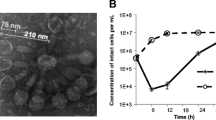Abstract
The effect of free chlorine onEscherichia coli populations was studied by chlorination of a population of 105 cells/ml. This cell density was low enough for the free-to-combined chlorine ratio to be 6.0∶1 or greater. The predominance of free chlorine resulted in rapid and complete population death.
Survivors obtained by dechlorination prior to complete population death were recovered equally well on nonselective and selective media. Although this suggests that survivors are not injured, evidence of survivor injury was observed.
Colonies resulting from growth of these survivors had a smaller diameter than colonies from unchlornated controls. This suggests that the chlorinated cells have an increased lag and provides indirect evidence of survivor injury. Injury was indicated directly by an increase in the lag time of surviving cells in slide culture. Variability in the severity of free-chlorine-induced injury was indicated by a broadened range in the survivor lag times.
Similar content being viewed by others
Literature Cited
American Public Health Association (1985) Standard methods for examination of water and wastewater, 15th edn. Washington DC: APHC
Bissonnette GK, Jezeski JJ, McFeters GA, Stuart DG (1975) Influence of environmental stress on enumeration of indicator bacteria from natural waters. Appl Microbiol 29:186–194
Camper AK, McFeters GA (1979) Chlorine injury and the enumeration of waterborne coliform bacteria. Appl Environ Microbiol 37:633–641
Hurst A (1977) Bacterial injury: a review. Can J Microbiol 23:935–944
Iandolo JJ, Ordal ZJ (1966) Repair of thermal injury ofStaphylococcus aureus. J Bacteriol 91:134–142
Ray B, Speck ML (1973) Enumeration ofEscherichia coli in frozen samples after recovery from injury. Appl Microbiol 25:499–503
Tomlins RI, Ordal ZL (1971) Precursor ribosomal ribonucleic acid and ribosome accumulation in vivo during the recovery ofSalmonella typhimurium from thermal injury. J Bacteriol 107:134–142
Verville KM (1984) PhD dissertation, University of Delaware.
Walsh SM, Bissonnette GK (1983) Chlorine-induced damage to surface adhesions during sublethal injury of enterotoxigenicEscherichia coli. Appl Env Microbiol 45:1060–1065
Zaske SK, Dockins WS, Schillinger JE, McFeters GA (1980) New methods to assess bacterial injury in water. Appl Env Microbiol 39:656–658
Author information
Authors and Affiliations
Rights and permissions
About this article
Cite this article
Verville, K.M., Herson, D.S. The effect of free chlorine onEscherichia coli populations. Current Microbiology 18, 235–241 (1989). https://doi.org/10.1007/BF01570298
Issue Date:
DOI: https://doi.org/10.1007/BF01570298



